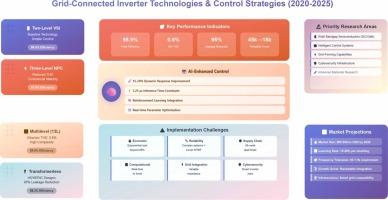并网逆变器拓扑结构与控制策略综述(2020-2025)
引用次数: 0
摘要
本文全面分析了2020年至2025年并网逆变器技术,揭示了从根本上挑战行业对技术进步和部署战略的假设的关键见解。定量分析表明,传统拓扑结构已经接近效率极限,2电平电压源逆变器达到96.5%,而先进的多电平系统达到98.9%。然而,边际收益的指数级成本增长意味着收益递减,这将重塑850亿美元市场演进中的投资优先级。调查揭示了之前无法量化的性能可靠性权衡,其中13级t型逆变器实现了0.6%的总谐波失真,但牺牲了运行寿命,由于元件缩放定律,将其从45,000 h减少到18,000 h,从根本上质疑先进的拓扑结构是否提供了卓越的价值主张。无变压器H5和高效可靠的逆变器概念(HERIC)设计成功地抑制了95%的泄漏电流,同时保持了98%或更高的效率,代表了实现广泛光伏集成的关键突破。尽管计算约束将推理限制在1.25 μs,但基于人工智能的控制显示出15-20%的动态响应改进,这揭示了智能电网实现的根本障碍。供应链分析揭示了关键的部署漏洞,组件交货时间超过26周,季度价格波动率为18.9%,表明如果没有供应链弹性,仅靠技术优势无法保证市场成功。该研究确定了5个优先研究领域——宽带隙半导体、智能控制、网格形成能力、网络安全基础设施和先进材料——为未来的发展提供了战略方向。这种方法通过成功地平衡技术性能、经济可行性和供应链约束来优先考虑电网的稳定性,而不是仅仅追求效率优化。本文章由计算机程序翻译,如有差异,请以英文原文为准。

A comprehensive review of grid-connected inverter topologies and control strategies (2020–2025)
This comprehensive review examines grid-connected inverter technologies from 2020 to 2025, revealing critical insights that fundamentally challenge industry assumptions about technological advancements and deployment strategies. Quantitative analysis demonstrates that conventional topologies have approached efficiency limits, with 2-level voltage source inverters achieving 96.5%, while advanced multilevel systems reach 98.9%. However, exponential cost increases for marginal gains indicate diminishing returns, which will reshape investment priorities across the $85 billion market evolution. The investigation reveals a previously unquantified performance-reliability trade-off, where 13-level T-type inverters achieve a total harmonic distortion of 0.6% but sacrifice operational lifetime, reducing it from 45,000 h to 18,000 h due to component scaling laws, fundamentally questioning whether advanced topologies provide superior value propositions. Transformerless H5 and highly efficient and reliable inverter concept (HERIC) designs successfully suppress leakage currents by 95%, while maintaining an efficiency of 98% or higher, representing critical breakthroughs that enable widespread photovoltaic integration. Artificial intelligence-based control demonstrates 15–20% dynamic response improvements, despite computational constraints limiting inference to 1.25 μs, which reveal fundamental barriers to intelligent grid implementation. Supply chain analysis reveals critical deployment vulnerabilities, with component lead times exceeding 26 weeks and 18.9% quarterly price volatility, indicating that technological superiority alone cannot guarantee market success without supply chain resilience. The study identifies 5 priority research areas—wide-bandgap semiconductors, intelligent control, grid-forming capabilities, cybersecurity infrastructure, and advanced materials—providing strategic direction for future development. This approach prioritises grid stability by successfully balancing technical performance against economic viability and supply chain constraints, rather than pursuing efficiency optimisation alone.
求助全文
通过发布文献求助,成功后即可免费获取论文全文。
去求助

 求助内容:
求助内容: 应助结果提醒方式:
应助结果提醒方式:


